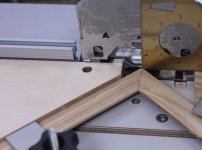I always use my DF500 with its fence, not its base, for registration purposes. There're many good reasons for that, but there're also some occasions where the base should be used or can only be used, such as milling mid-shelf joints. Another common use of the base for registration is when I use it with the Veritas Joinery Table. Here, instead of using the usual table saw jig to cut the centered miter slots for the 1/2" x 1" custom frame, I turned to my DF500:
[attachimg=1]
It's futile to try to use the fence for this job (you can by attaching a spacer block underneath the fence, but consistency is not guaranteed unlike using the base/Veritas Joinery Table).
[attachimg=1]
It's futile to try to use the fence for this job (you can by attaching a spacer block underneath the fence, but consistency is not guaranteed unlike using the base/Veritas Joinery Table).

